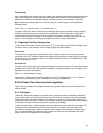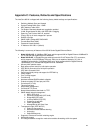44
Appendix C: Features, Defaults and Specifications
The IntraCore 65120 is shipped with the following factory default settings and specifications:
• Switching Method: Store-and-forward
• System Packets Buffer Size: 1.5MB
• MAC Address Table: 8000
• Full-Duplex: Standards-based auto-negotiation enabled
• VLAN: 64 port-based VLANs, with IEEE 802.1Q tagging
• Spanning Tree Protocol: 802.1D, enabled
• Priority: 802.1p, 8 levels mapped to 2 queues
• RMON: 4 Groups
• SNMP: MIB-II, Bridge MIB, RMON MIB
• Console Baud Rate: 9600
• Password: Asante (default)
• IP Address: 192.168.0.1 (default)
The following is a summary of features of the 65120 Series Gigabit Ethernet Switch:
• Model 65120-12G: 12 1000Base GBIC ports, which supports 802.3z Gigabit Ethernet 1000BaseSX
or LX, and 802.3ab Gigabit Ethernet 1000BaseT
• Model 65120-2G: 10 Gigabit Ethernet switched ports with RJ-45 Twisted Pair (TP) connectors,
which supports 10/100/1000BaseT Ethernet. Each port is capable of detecting 10, 100, or
1000Mbps automatically; 2 1000Base GBIC ports, which supports 802.3z Gigabit Ethernet
1000BaseSX or LX, and 802.3ab Gigabit Ethernet 1000BaseT
• 8K-entry MAC address cache
• Back pressure flow control for half-duplex operation
• IEEE 802.3x flow control for full duplex operation
• IEEE 802.1Q based VLAN
• QoS through dual priority and support for IEEE 802.1p
• IGMP support
• Port Trunking support
• Port Mirroring
• Hardware assisted RMON statistic collection
• Extensive system LED and per port LEDs
• Console port (VT100)
• Telnet remote login
• Web-based management
• On-Board HTTP Server
• Network boot/software download via TFTP
• SNMP-based network management
o MIB ll (RFC1213)
o Ethernet Interface MIB (RFC1643)
o Bridge MIB (RFC1493)
o 4-Group RMON (RFC1757)
o Enterprise private MIB
o IGMP upgradeable
o Manageable by HP Open View
• Transparent bridge (IEEE 802.1D)
o Spanning tree protocol
o Hardware assisted address learning
o Auto aging
o Static address entry
• Supports a “Store and Forward” switching engine
• Multimedia support
• An intelligent address recognition mechanism enables forwarding at full wire speed


















